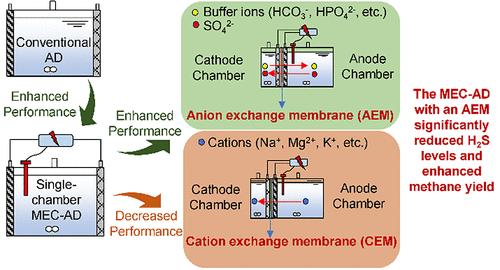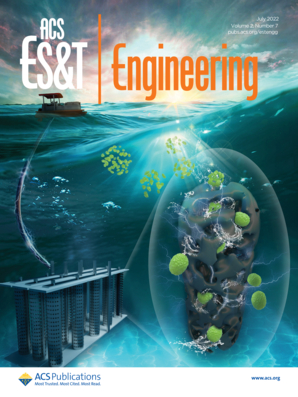探索硫酸盐还原条件下电辅助厌氧消化器的最佳配置:膜的重要性和机理启示
IF 7.4
Q1 ENGINEERING, ENVIRONMENTAL
引用次数: 0
摘要
硫酸盐还原产生的硫化物通常是厌氧消化(AD)的抑制剂。本研究考察了在硫酸盐还原条件下运行的三种微生物电解池辅助厌氧消化(MEC-AD)系统的性能:单室、带阴离子交换膜(AEM)的双室和带阳离子交换膜(CEM)的双室。一般来说,单室 MEC-AD 反应器的甲烷产量(74.5-75.0%)明显高于对照组(64.4%)。使用 AEM 将单室 MEC-AD 转换为双室配置后,甲烷产量进一步提高到 80.6%。膜促进了缓冲阴离子向阳极和硫酸盐向阴极的转移,从而大大降低了阳极室中未电离硫化物的浓度。带有 AEM 的 MEC-AD 还显示出更高的特定产甲烷活性、电流密度和微生物多样性,富集了电活性细菌(如革兰氏菌、气单胞菌)和养氢型甲烷杆菌。然而,带有 CEM 的 MEC-AD 反应器的甲烷产量显著减少(63.2%),主要原因是溶解液酸化,增加了未电离硫化物的浓度。本文章由计算机程序翻译,如有差异,请以英文原文为准。

Exploration of Optimum Configurations of Electro-Assisted Anaerobic Digester for Sulfate-Reducing Conditions: Significance of Membranes and Mechanistic Insights
Sulfides generated from sulfate reduction commonly act as inhibitors in anaerobic digestion (AD). This study examined the performance of three configurations of microbial electrolysis cell-assisted anaerobic digestion (MEC-AD) systems: single-chamber, dual-chamber with an anion exchange membrane (AEM), and dual-chamber with a cation exchange membrane (CEM), operated under sulfate-reducing conditions. In general, the single-chamber MEC-AD reactors exhibited significantly higher methane yields (74.5–75.0%) than the control (64.4%). Upon converting a single-chamber MEC-AD to a dual-chamber configuration using an AEM, methane yield further increased up to 80.6%. The membrane facilitated the transfer of buffer anions to the anode and sulfate to the cathode, which substantially reduced un-ionized sulfide concentrations in the anode chamber. The MEC-AD with an AEM also demonstrated increased specific methanogenic activities, current densities, and microbial diversity with the enrichment of electroactive bacteria (e.g., Geobacter, Aeromonas) and hydrogenotrophic Methanobacterium. However, the MEC-AD reactor with a CEM experienced a significant reduction in methane yield (63.2%), mainly due to anolyte acidification, which increased the un-ionized sulfide concentrations.
求助全文
通过发布文献求助,成功后即可免费获取论文全文。
去求助
来源期刊

ACS ES&T engineering
ENGINEERING, ENVIRONMENTAL-
CiteScore
8.50
自引率
0.00%
发文量
0
期刊介绍:
ACS ES&T Engineering publishes impactful research and review articles across all realms of environmental technology and engineering, employing a rigorous peer-review process. As a specialized journal, it aims to provide an international platform for research and innovation, inviting contributions on materials technologies, processes, data analytics, and engineering systems that can effectively manage, protect, and remediate air, water, and soil quality, as well as treat wastes and recover resources.
The journal encourages research that supports informed decision-making within complex engineered systems and is grounded in mechanistic science and analytics, describing intricate environmental engineering systems. It considers papers presenting novel advancements, spanning from laboratory discovery to field-based application. However, case or demonstration studies lacking significant scientific advancements and technological innovations are not within its scope.
Contributions containing experimental and/or theoretical methods, rooted in engineering principles and integrated with knowledge from other disciplines, are welcomed.
 求助内容:
求助内容: 应助结果提醒方式:
应助结果提醒方式:


